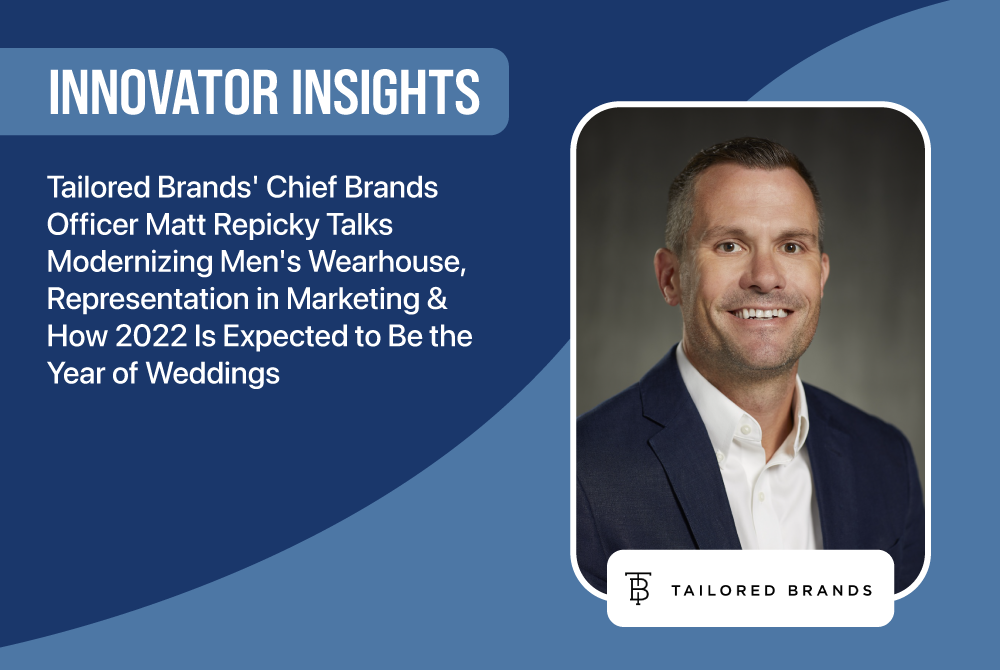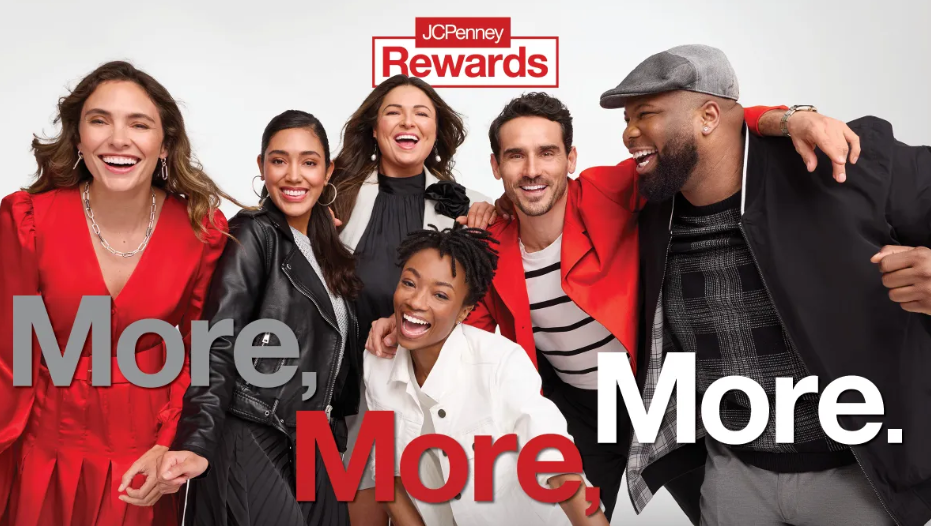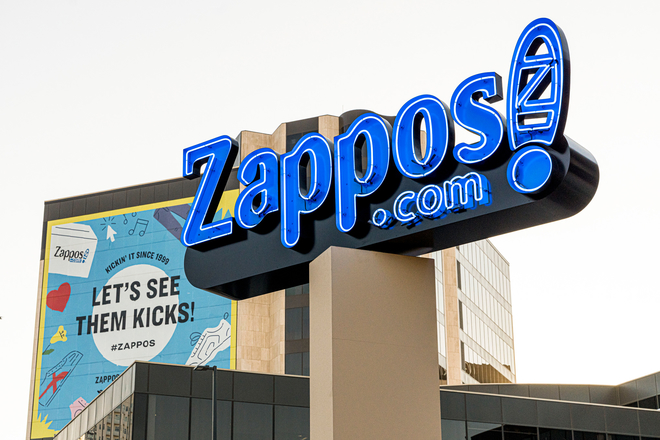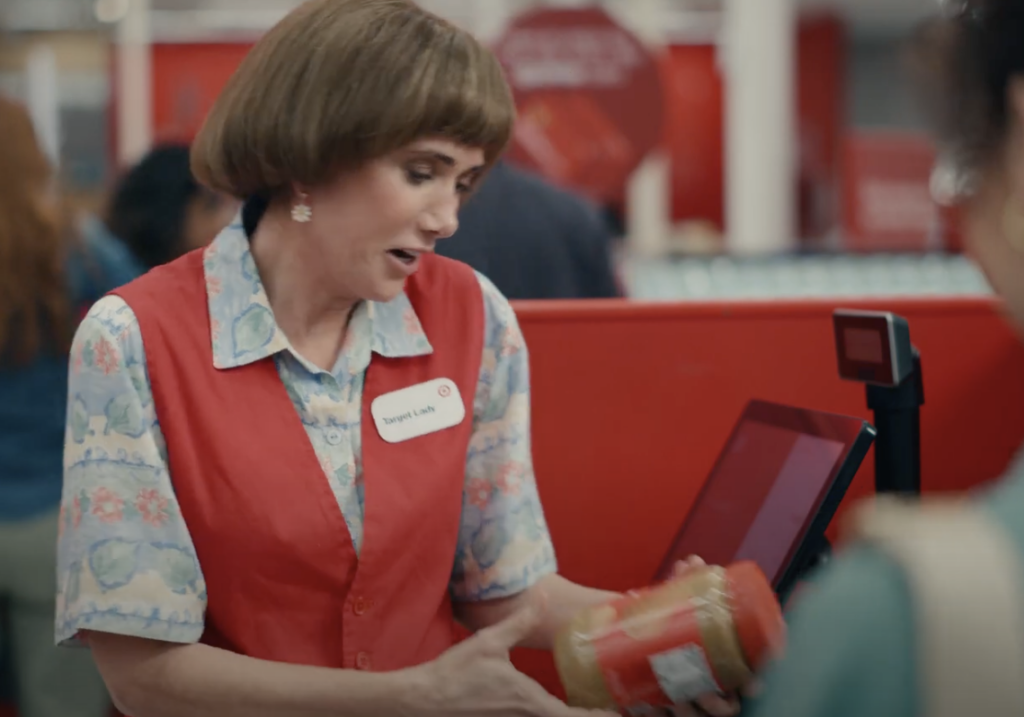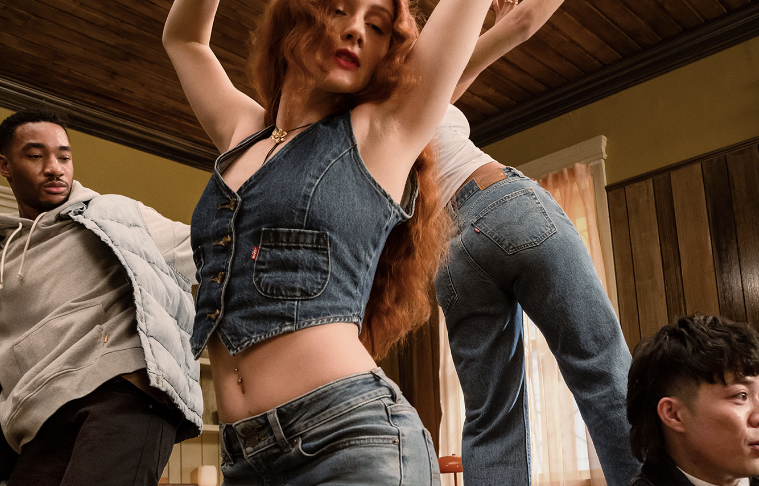Matt Repicky, chief brands officer at Tailored Brands, is trying to accomplish a couple of things.
“One is that coming out of the pandemic, I think a lot of brands were hyper focused on return on investment and really lower funnel activities, but neglected the brand part of the work,” says Repicky.
“As we look at our portfolio at Tailored Brands, we feel like there’s an opportunity to re-engage and reintroduce ourselves to customers,” he says. “First and foremost, that was one of the key reasons why we crafted my role, the way that it’s been built. Another is to really have an overview on what our brand strategy is.”
One of the key things that Repicky is going to be doing is creating a multi-year brand strategy around things like brand health using customer insights to inform creative strategy. “Ultimately, my job is brand evangelist for each of the brands in our portfolio,” he says.
Tailored Brands’ portfolio includes: Men’s Wearhouse, Jos. A. Bank, Moores and K&G Fashion Superstore.
Prior to joining Tailored Brands as SVP/CMO of Jos. A. Bank, Repicky worked as CMO of Genexa; head of global brand marketing for Barbie; head of marketing for Amazon’s MyHabit; and vice president of marketing at The Jones Group.
At Amazon, Repicky worked in their fashion division out of New York. “Working in that environment taught me so clearly the benefit of being agile and having a test and learn mindset and not sitting on the status quo,” he explains. “There it was, let’s try something new and keep cycling through. If it works, you scale it. If it doesn’t work, you understand why and move on. That’s something I really bring to my leadership style today, which is always pushing for doing what’s working, but always trying to cycle through and find newness and new ways to approach our customers.”
He also led global brand marketing for Barbie for about four years during a time of immense transformation for the brand. The company was trying to renew the brand in the eyes of the consumers and reestablish the benefit of the brand to kids and how the dolls were a necessary part of play.
“That was done through the lens of our brand purpose, and every sort of marketing decision we made, was through the lens of does this deliver on the purpose or not?,” says Repicky. “Representation and diversity and inclusion were so paramount to delivering on that purpose. It always felt that if a child is at a Walmart and they can see a doll on the shelf that looks like them, that means something. That’s similar to the work that we’re doing today on Men’s Wearhouse. Representation is table stakes and what people expect from you. And I’m proud of what we’re doing so far, but we always have more work to do.”
Brand Innovators caught up with Repicky from his home office in the San Francisco Bay Area to talk about marketing weddings, the importance of diversity in advertising and how retail has shifted since the pandemic began. This interview has been edited for clarity and length.
Can you talk about some of the current marketing and branding efforts you’re doing with the brands within the portfolio?
Men’s Wearhouse – probably the best known brand in our portfolio – recently introduced a new national brand campaign called “Love the Way You Look,” which is using a couple of really key insights. One was that the awareness for the brand was really counted on. George Zimmer, who founded Men’s Wearhouse, spent years and years and years with a consistent tagline of “You’re going to like the way you look, I guarantee it.” And that still resonates with consumers today. From consumer research, we knew that there was built in equity there, and it was positive equity. So we felt like this was a really nice extension to modernize what that line represented, and capture this idea of loving the way you look. You don’t want to just like the way you look, you want to actually love the way you look. We know from consumer insights, that the confidence that men feel when they’re getting dressed up is a really important part of how they evoke and express themselves.
We kicked off his campaign in early April and we did it through the lens of weddings, because the other insight that we have is that this is going to be the year with the largest number of weddings in the United States since 1984. There’s around 2.6 million weddings planned this year. We really want to capture the marketplace and really show that we are the destination not just for the groom, but also the groomsmen and the hundreds of millions of wedding guests who are going to be attending an event this year. So we launched the “Love the Way You Look” national integrated campaign.
It’s a way for us to reintroduce ourselves to consumers in a new modern and contemporary way.
One of the other major pivots that I’ve been making across the portfolio, but really acutely at Men’s Wearhouse is diversity and inclusion. We have just increased representation in all of our marketing and advertising. We just had a prom campaign that we launched a couple of months ago that was the most diverse casting we’ve ever done. We had models who are non-binary, who are trans , who are Native American, really wanting to showcase what teens are seeing around them today. In the wedding space, we’ve been shooting same real sex couples using female photographers looking at what is the diversity in front and behind the camera.
Can you talk about how focusing on diversity ties into your brand purpose?
We have a purpose as a company to inspire our customers to love the way that they look in all those special moments that matter. It’s critical, frankly it is table stakes today, to make sure that the way that you showcase that is wholly representative of your customer. If we’re only showing one segment of our customer population, then we’re not fulfilling our mission of servicing everybody who walks through our door.
One key competitive point of difference across all of our brands is high touch incredible customer service. I get stories all the time of a store manager who drove a tuxedo to a church to get it on time for the wedding, or a prom kid pops into the store to get his tux altered on the way to the dance. Our ability to serve all of our customers is what Men’s Wearhouse and our entire brands portfolio is known for. One way we can do that is showing the entirety of our customer base in our marketing and advertising. And we’ve been doing more of this DE&I work on the marketing front. I get feedback from store employees who say they feel better represented, they feel like the company is now embracing their individual identities and then that translates to the customers as well.
Can you talk about how the retail experience has shifted since the pandemic and what that means for your brands?
It pushed us towards increased innovation. We started offering “Buy online, Pick up in store.” We started offering curbside service. The pandemic forced us to think differently about what the retail experience was like. One of the things that we’re just always known for, working one on one with a customer, understanding their needs and going above and beyond. We have tailors at all of our stores. I don’t think anybody else, especially at a national chain level has that level of service and the ability to accommodate anything that a customer needs. One of the major shifts is that customers now are using online search for discovery and exploration. They still may likely come into our stores to begin to get that level of service and really see the selection, but they’re learning about the brand and about the product in different ways than they were before. We have to show up and be in front of the customer in those channels to make sure that we’re under consideration.
How are you showing up digitally to reach younger consumers?
That’s been something that I’ve had my eye on for a while. We are always trying to get ahead and make sure that we’re in front of our audiences. For example, in the wedding business, we turned on advertising on Pinterest about a year and a half ago. We’d never done that before. But as I think about the bride as a primary decision maker in the wedding planning process, we needed to talk to her as well and feel like our experience was aspirational for her ,as well as her partner. And Pinterest has half a billion wedding pins every year so that was a natural place for us to extend and show up. That’s also been really successful for us in the prom space.
We just started advertising on Twitch for the first time ever. You think about gaming and console play and that is where a teen audience is. We’re going to figure out how we explore that more. Like a lot of brands, we are doing a lot more on TikTok. It’s really about how do we create the right content for each of those platforms? It’s not enough to say we have a spot or we have a piece of creative and now we can just farm it out everywhere. We actually need to create unique assets for the channel specifically.
Is there a place for the metaverse or NFTs for any of your brands?
It’s definitely something we’re exploring. It’s about how do we bring it to life in a way that feels authentic for our brands and is expected by our customers. We sit in a space where we’re servicing a lot of really exciting and core events. How do we show up through that lens? What does it mean for someone to interact with or experience a Men’s Wearhouse fitting in the metaverse? I think this is also something that we need to get our arms around. I don’t think we have an answer yet but we are definitely exploring where our rightful place is in that world.
What are you most excited about for the rest of 2022?
More weddings. I’m excited by the return of some pre-pandemic behaviors, but taking into account all the things we’ve learned over the past two and a half years and not going back to the way things necessarily were, which I think is fantastic. For the rest of 2022, I’m excited to recapture these special events and again and show that our brands are the place that can service some of those 2.6 million weddings and every other special moment that folks are going to have in the back half of the year.
